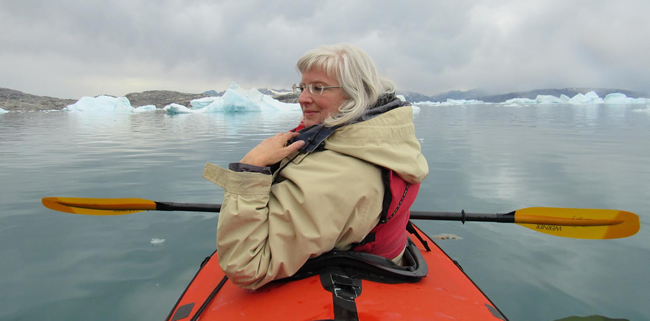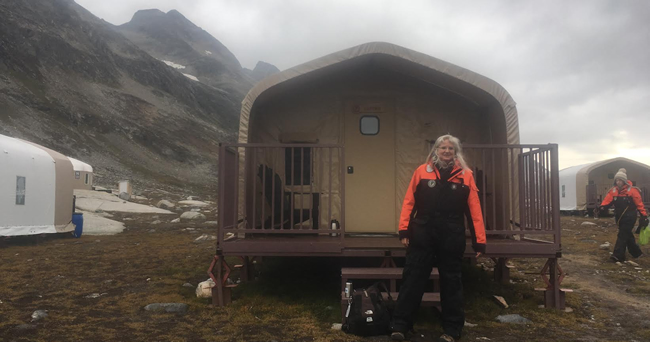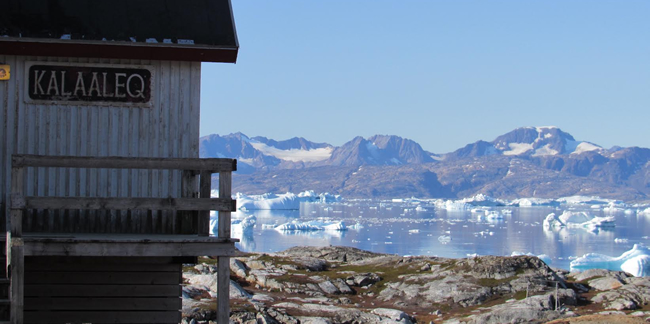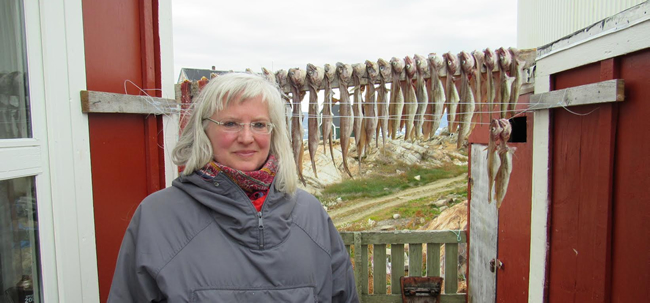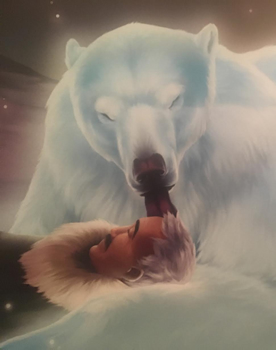

Up Close: Erica Ferencik
A Chilling Journey into the Impossible
Erica Ferencik’s chilling new thriller, GIRL IN ICE, begins with a premise few writers could resist. Set in the unforgiving landscape of the Arctic Circle, a successful linguist ventures north to try and communicate with a young girl who has been thawed from the ice alive—and is now speaking a dead language.
It’s a professional challenge Valerie Chesterfield can’t pass up—but her intentions are not entirely pure. Reeling from the loss of her twin brother—a suspected suicide—Val is desperate to learn the truth about his death. But to do so, she’ll need to face her own fear of the cold.
In this The Big Thrill interview, Ferencik, author of The River at Night and Into the Jungle, shares insight into the type of research required to write GIRL IN ICE, how stand-up comedy has enhanced her work, and her top piece of advice for aspiring authors.
You traveled to Greenland as part of your research for GIRL IN ICE. Did you have a story in mind when you began your trip? Or did the story come to you through your experience?
One of the first inspirations for GIRL IN ICE came from one of the final scenes in the original, 1931, black and white version of Frankenstein. It has haunted me since the day I saw it, more than 40 years ago.
Frankenstein’s monster, hunted, bloodied, in despair, has given up on finding any kindness or acceptance from mankind. He turns from the camera and lurches forward into an unforgiving Arctic landscape, a mad blizzard swirling all around him. Slowly, his blocky, black silhouette is devoured by all the ravenous white, and he is gone. This image broke my heart in ways I’m still trying to parse, but I think it has to do with human cruelty, and our intolerance for our own human variety.
There is no Frankenstein’s monster in GIRL IN ICE, but that feeling of desolation and desperation—as well as the stunning Arctic landscape—is something I’ve always wanted to render somehow in one of my novels.
The actual spark for the book happened one bitterly cold morning in the winter of 2018. I was walking in the woods near my home and came upon three juvenile painted turtles frozen mid-stroke in the ice along the shallow edge of a pond. They didn’t look alive…but they didn’t look dead either. It turns out there are some animals (and plants too!) that have this freezing-and-coming-back-to-life thing down. Painted turtle hatchlings, some species of beetle, wood frogs, certain alligators, even an adorable one-millimeter length creature called a Tardigrade or “water bear” that can be frozen to -359C and thaw out just fine. Most of these creatures possess a certain cryo-protein that protects their cells from bursting when they freeze.
A protein that…we don’t possess. Still, the image of a young girl frozen in a glacier in the Arctic popped into my head. From there, I asked myself: How did she get there? What was her story?
After I had a first draft of the novel, I made plans for a research trip to Greenland. I need to know my story before I go on these trips, otherwise I don’t know what interviews to set up or what exactly to take note of.
What was the most surprising thing you learned from that research?
This is going to sound silly, but the fact that Greenland is so big, just so vast, and yet so few people live there was hard to wrap my mind around. Only 57,000 people—one tenth the residents in all of Wyoming—call this island, the largest in the world at about a third the size of Canada, home. Most live in Nuuk, the capital; the rest live in towns often with fewer than 500 inhabitants along a 3,000-mile coastline, mostly on the west side. The ice sheet measures 1,500 miles north to south, is two miles deep at its thickest, covers 80 percent of the land mass, and has been frozen for three million years.
The second thing that shocked me was how close Greenland is to pre-history. As recently as 1950, people lived in sod huts: low, square dwellings built by digging a hole in the ground during the short summer season—plus or minus 50 days—then creating a supporting structure for a roof out of whale ribs or driftwood, finally sealing it with skins, peat, and rocks.
And it’s one thing to read that the present-day economy is mostly subsistence hunting and fishing; it’s another to witness it, read about quotas for narwhal and minke whale, learn what happens when a polar bear is spotted (it’s not gentle), understand that sled dogs are seen as possessions—not pets—that need to be fed. And, sad as it is to witness for someone unaccustomed to this life, it’s cheaper to hunt seal than cough up five dollars for a can of imported dog food.
Most shocking of all? There are no penguins.
How about your most memorable experience during your trip to Greenland?
I had the opportunity to interview the mayor of a small town, and I mean small, just 185 people. He was 70 years old, had been born in a sod hut similar to what I’ve described above. At age seven, he, his family, and the two other families he was living with moved out of it and into a simple wooden home. I asked him how he felt about it, thinking he would express relief or excitement about the change in his life.
His answer stunned me. He said that as much as he appreciated electricity, running water, and other conveniences, the truth was he missed the closeness he experienced living basically underground in these extremely cramped conditions, for 10 months of the year as snowstorms raged outside and temperatures plummeted. The experience of surviving these conditions as a group, hunting together, sharing every scrap of food, making up games, songs, stories together, created a kind of intimacy he misses to this very day.
GIRL IN ICE is a story about language. How did you go about learning the linguistics necessary to tell this story about two people seeking connection?
I immersed myself in the sounds and cadences of the living Nordic languages, among them Swedish, Danish, Norwegian, Icelandic, and of course Greenlandic, in order to get a feel for inflection and tone. I also dove into recordings of Old Norse, the main language of the Vikings, in order to create morphemes, or units of meaning that sounded Nordic, but that were just slightly distinct from known languages, so I could create Sigrid’s unique tongue.
What I had to grapple with next was: How would Val be able to interpret Sigrid’s speech if there was no correlation to any living or even dead language? I consulted some linguist friends who said that without any remnants of written language or cultural clues from a society that spoke the language—with nothing to go on, basically—you’d have to start with simple nouns, verbs, and concepts, almost like a baby pieces together her language.
But for two people to communicate, they have to both want to, or need to, and only when Sigrid realizes she must communicate to survive does she make the effort.
The plot touches upon deadly ice storms; are these a real current threat stemming from global warming?
There are such things as katabatic winds; in Greenland they’re called piteraqs: brutally strong winds generated by radically different air temperatures, often barreling down the slopes of mountains or glaciers. I’m not a climate scientist or meteorologist. But I do know that climate change strengthens hurricanes, tornadoes, and wind events in general, as well as prompting dramatic swings in temperature, so I thought it wasn’t too far of a reach—for story purposes—to conjecture that deadly ice storms are in our future and might have been in our past.
Are there ways in which your decade doing stand-up and sketch comedy has influenced your writing of fiction?
They say that comedy is the angry art. And it’s true. As long as you’re funny, you get to go up there and rail against what you perceive as unfair, wrong, absurd, and so on. There is a lot of darkness in comedy. In fact, I defy you to tell me an actually funny grownup joke without a dark, or tragic, or sad kernel. Jokes about happy things aren’t funny. This is why people love comedy: someone, up there onstage, is calling out things that have bothered them or pissed them off for decades, but they didn’t know how to articulate it.
When I was doing stand-up or sketch comedy, I was a frustrated writer with several terrible novels in my drawer but with a hunger to be seen and heard. Getting up on stage and letting it rip was instant publication: immediate feedback. It taught me to think on my feet. It taught me discipline: you had to come up with new jokes all the time.
Comedy demands keen powers of observation. If you’re not paying attention, taking notes about what you see, hear, and feel, then take the second step and ask yourself Why is this funny, how can you come up with material? Never mind asking yourself How can I process this through the lens of who am I as a comic?
But the first step is always: observe.
Which is also a crucial skill for a novelist.
Bravery is a muscle we all exercise every day, especially these days, but doing stand-up was where I practiced bravery, night after night, for years. It took me a while to really grok that comedy isn’t one way—you’re not just dumping jokes on people—it’s a conversation with the audience. After delivering a punchline, you must give your audience a chance to react. If you don’t, they will sense your fear and eat you alive.
So many people ask me these days: Weren’t you frightened, kayaking between massive icebergs, knowing if they calved or split, waves could hurl you into thirty-degree water? What about the giant anacondas coiled in the trees over your canoe as you threaded through the floating forest by moonlight when you were researching Into the Jungle? I would say that for all those scenarios you can lower your risk: you can find a great guide, wear the right gear, pack a machete of your own. But try standing in front of 500 people waiting for them to laugh at a joke that seemed hilarious in the shower that morning. That has to be the scariest journey of all.
What is your next writing adventure?
Can’t tell you too much yet, but it’s an eco-thriller that poses the question What happens when nature strikes back at humankind’s attempts to destroy it? The protagonist must somehow solve the paradox How do you defeat an enemy you desperately need for your own survival?
You’ve been in the writing industry for 35 years. As you know, many of the people who read The Big Thrill are also writers and budding authors. What is one piece of advice that you have carried with you?
I took rejection hard over the decades before my first novel was published. And trust me, the demons still want in. There are days I beat myself up for perceived shortcomings more than I actually write. I castigate myself for not being able to produce when it’s time to produce, for creating words, sentences—entire stories—that don’t live up to what I’d conjured so clearly and beautifully in my head. So see? I don’t always live by my own advice. Hell, I even beat myself up for beating myself up.
But here’s what I’ve learned:
Each cell in your body replaces itself every seven to ten years. It stands to reason that you will literally be a different writer in your twenties, thirties, forties, fifties, and beyond. Each writer you were, are, or will become is important, valid, and frankly wonderful. Sure, we’ve all got the stories—maybe even whole novels—shoved in the drawer, but without having written them, it’s quite possible you couldn’t have moved on to what you’re working on these days, and admit it: You love what you’re working on now, right? And who knows? Maybe—in one of those squirreled-away manuscripts—an idea for a new novel or screenplay lurks, some key to the opus you were born to write. It happens all the time. It happened to me.
And take a good hard look at that toxic word success. If I had bought the definition of success as being a bestselling author—or in my case, even a published author—at five, ten, 15, even 25 years of writing, I would have given up. Do marathon runners define success by winning marathons? They do not. They train daily, they keep track of small improvements, notice what ramps up their performance. And damn, they love to run, no matter what the weather.
Do the same with your writing career: Never stop learning, never stop working; play the long game. Continually update what “success” means to you because for any of us it can change daily. It could mean writing a beautiful sentence or paragraph one day, the next meeting the deadline for a contest, or finally understanding the secrets of sizzling dialogue.
No matter how your work is received, you must hold on to that tiny flame inside your belly that got you in all this trouble in the first place: the kryptonite-hard belief that you have a way of seeing the world that adds value to a reader’s life. Writing a piece of fiction is an act of love, of generosity, as a painting is the marriage of a painter’s interpretation of what she sees with her unshakable belief that the viewer will be enriched by her vision, or the dancer his dance, and so on.
- THE GOD IN THE SEA with Paul Kemprecos - April 4, 2024
- FOR WORSE with L. K. Bowen - April 4, 2024
- HIT AND RUN with Vincent Zandri - April 4, 2024



